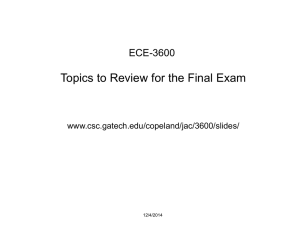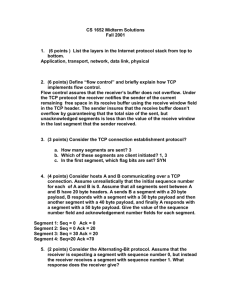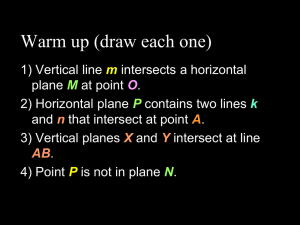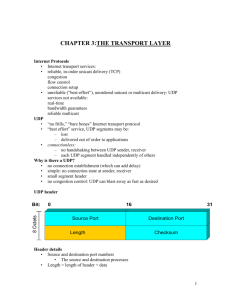k. Again suppose TCP Tahoe is used, and there is a timeout event at
advertisement
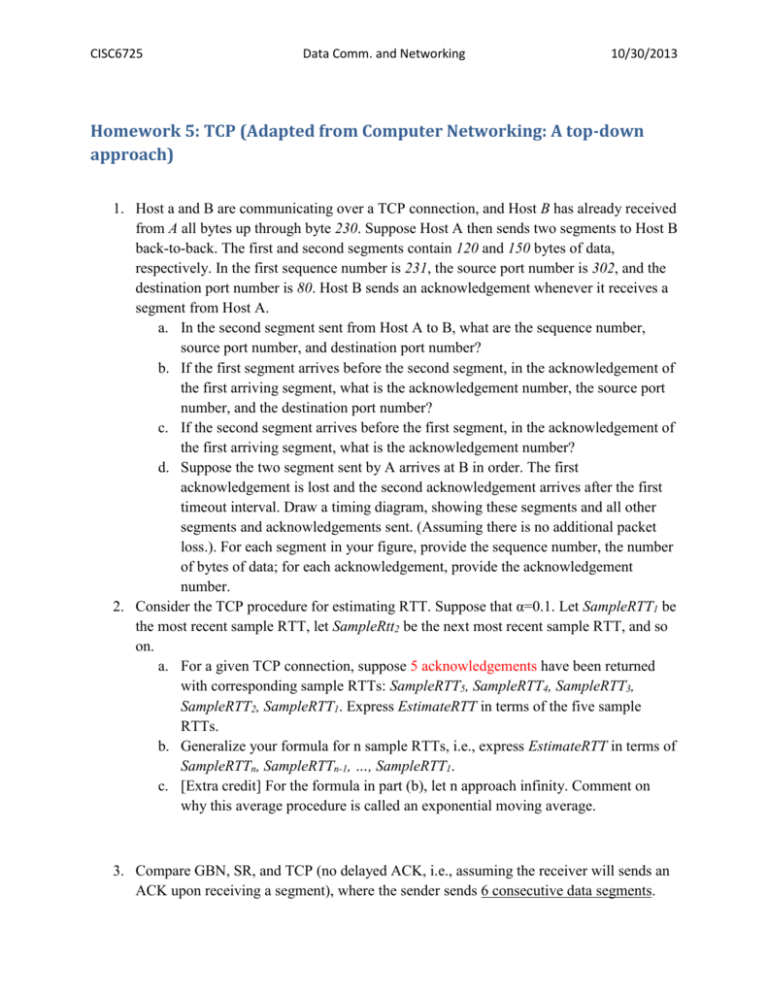
CISC6725 Data Comm. and Networking 10/30/2013 Homework 5: TCP (Adapted from Computer Networking: A top-down approach) 1. Host a and B are communicating over a TCP connection, and Host B has already received from A all bytes up through byte 230. Suppose Host A then sends two segments to Host B back-to-back. The first and second segments contain 120 and 150 bytes of data, respectively. In the first sequence number is 231, the source port number is 302, and the destination port number is 80. Host B sends an acknowledgement whenever it receives a segment from Host A. a. In the second segment sent from Host A to B, what are the sequence number, source port number, and destination port number? b. If the first segment arrives before the second segment, in the acknowledgement of the first arriving segment, what is the acknowledgement number, the source port number, and the destination port number? c. If the second segment arrives before the first segment, in the acknowledgement of the first arriving segment, what is the acknowledgement number? d. Suppose the two segment sent by A arrives at B in order. The first acknowledgement is lost and the second acknowledgement arrives after the first timeout interval. Draw a timing diagram, showing these segments and all other segments and acknowledgements sent. (Assuming there is no additional packet loss.). For each segment in your figure, provide the sequence number, the number of bytes of data; for each acknowledgement, provide the acknowledgement number. 2. Consider the TCP procedure for estimating RTT. Suppose that α=0.1. Let SampleRTT1 be the most recent sample RTT, let SampleRtt2 be the next most recent sample RTT, and so on. a. For a given TCP connection, suppose 5 acknowledgements have been returned with corresponding sample RTTs: SampleRTT5, SampleRTT4, SampleRTT3, SampleRTT2, SampleRTT1. Express EstimateRTT in terms of the five sample RTTs. b. Generalize your formula for n sample RTTs, i.e., express EstimateRTT in terms of SampleRTTn, SampleRTTn-1, …, SampleRTT1. c. [Extra credit] For the formula in part (b), let n approach infinity. Comment on why this average procedure is called an exponential moving average. 3. Compare GBN, SR, and TCP (no delayed ACK, i.e., assuming the receiver will sends an ACK upon receiving a segment), where the sender sends 6 consecutive data segments. CISC6725 Data Comm. and Networking 10/30/2013 Assume that the timeout values for all three protocols are sufficiently long such that all 6 data segments and their corresponding ACKs can be received (it not lost in the channel) by the receiving host (Host B), and the sending host (host A) respectively. Suppose the 2nd segment is lost. After one retransmission, all 6 data segments have been correctly received by host B. a. Draw the operations of the three protocols, GBN, SR, and TCP. For each segment sent, labeled it with the sequence number; and for each acknowledgement, labeled it with the sequence number too. You can assume that for TCP, the initial sequence number is 120, and the each segment contains 1000 bytes of data. b. How many segments has Host A sent in total, and how many ACKs has Host B sent in total? What are their sequence numbers? Answer these questions for all three protocols. c. If the timeout values for all three protocols are much longer than 6 RTT, then which protocol successfully delivers all five data segments in shortest time interval? d. For TCP protocol, how many measurements for RTT have been taken in total? Recall that TCP does not measure round trip time for retransmitted segments. 4. Consider sending a large file from a host to another over a TCP connection that has no loss. a. Suppose TCP uses AIMD for its congestion control without slow start. Assume cwnd increases by 1 MSS every time a batch of ACKS is received and assuming approximately constant round-trip times, how long does it take for cwnd increase from 6 MSS to 14 MSS (assuming no loss events)? b. What is the average throughput (in terms of MSS and RTT) for this connection up through time = 6RTT? 5. Consider that only a single TCP (Reno) connection uses one 100Mbps link which does not buffer any data. Suppose that this link is the only congested link between the sending and receiving hosts. Assume that the TCP sender has a huge file to send to the receiver, and the receiver buffer is much larger than the congestion window. We also make the following assumption: each TCP segment size is 1,400 bytes; the two-way propagation delay of this connection is 100 msec; and this TCP connection is always in congestion avoidance phase, that is, ignore slow start. a. What is the maximum window size (in segments) that this TCP connection can achieve? b. What is the average window size (in segments) and the average throughput (in bps) of this TCP connection? CISC6725 Data Comm. and Networking 10/30/2013 c. How long would it take for this TCP connection to reach its maximum window again after recovering from a packet loss? 6. Consider Figure 3.58. Assuming TCP Reno is the protocol experiencing the behavior shown above, answer the following questions. In all cases, you should provide a short discussion justifying your answer. a. Identify the intervals of time when TCP slow start is operating. b. Identify the intervals of time when TCP congestion avoidance is operating. c. After the 16th transmission round, is segment loss detected by a triple duplicate ACK or by a timeout? d. After the 22nd transmission round, is segment loss detected by a triple duplicate ACK or by a timeout? e. What is the initial value of ssthresh at the first transmission round? f. What is the value of ssthresh at the 18th transmission round? g. What is the value of ssthresh at the 24th transmission round? h. During what transmission round is the 70th segment sent? i. Assuming a packet loss is detected after the 26th round by the receipt of a triple duplicate ACK, what will be the values of the congestion window size and of ssthresh? j. Suppose TCP Tahoe is used (instead of TCP Reno), and assume that triple duplicate ACKs are received at the 16th round. What are the ssthresh and the congestion window size at the 19th round? k. Again suppose TCP Tahoe is used, and there is a timeout event at 22nd round. How many packets have been sent out from 17th round till 22nd round, inclusive? TCP Congestion Window size as a function of time







